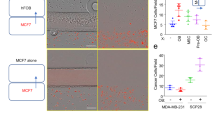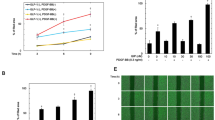Abstract
Osteopontin (OPN) is a secreted, integrin-binding glycophosphoprotein that has been implicated in breast cancer. We previously showed that OPN-induced cell migration of mammary epithelial cells (MEC) depends on binding to cell surface integrins and involves activation of the hepatocyte growth factor (HGF) receptor, Met. Here, we show that OPN-induced migration of MEC also requires activation of the epidermal growth factor (EGF) pathway. Synergism was seen between EGF and OPN in inducing cell migration. Furthermore, incubation of cells with exogenous OPN increased ligand (TGFα> EGF) and EGF receptor (EGFR) mRNA expression, as well as EGFR kinase activity. Treatment of cells with anti-TGFα or anti-EGFR antibody, or with tyrphostin-25 (EGFR inhibitor), significantly impaired the cell migration response to OPN. Other more broad-spectrum tyrosine kinase inhibitors and the growth factor/ receptor interaction inhibitor, suramin, also inhibited OPN-induced migration. Using specific signal transduction pathway inhibitors, we have screened for involvement of MEK (MAP kinase kinase), phosphatidylinositol 3-kinase, phospholipase C (PLC), and protein kinase C (PKC). Results implicated all of these pathways in OPN-induced cell migration, the most pronounced effect being seen with PLC and PKC inhibitors. These results suggest that induction of MEC migration by OPN involves a cascade of events including at least two growth factor/receptor pathways and multiple downstream signal transduction pathways. A number of potential targets are thus provided for strategies aimed at blocking the malignancy-promoting effects of OPN.
This is a preview of subscription content, access via your institution
Access options
Subscribe to this journal
Receive 50 print issues and online access
$259.00 per year
only $5.18 per issue
Buy this article
- Purchase on Springer Link
- Instant access to full article PDF
Prices may be subject to local taxes which are calculated during checkout







Similar content being viewed by others
References
Adelsman MA, McCarthy JB and Shimizu Y . (1999). Mol. Biol. Cell, 10, 2861–2878.
Band V, Zajchowski D, Swisshelm K, Trask D, Kulesa V, Cohen C, Connolly J and Sager R . (1990). Cancer Res., 50, 7351–7357.
Bellahcène A and Castronovo V . (1995). Am. J. Pathol., 146, 95–100.
Brown LF, Papadopoulos-Sergiou A, Berse B, Manseau EJ, Tognazzi K, Peruzzi CA, Dvorak HF and Senger DR . (1994). Am. J. Pathol., 145, 610–623.
Comoglio PM . (1993). EXS., 65, 131–165.
Derynck R, Roberts AB, Winkler ME, Chen EY and Goeddel DV . (1984). Cell, 38, 287–297.
Donato NJ, Gallick GE, Steck PA and Rosenblum MG . (1989). J. Biol. Chem., 264, 20474–20481.
Furger KA, Menon R, Tuck AB, Bramwell VHC and Chambers AF . (2001). Curr. Mol. Med., 1, 621–632 (invited review).
Giancotti FG and Ruoslahti E . (1999). Science, 285, 1028–1032.
Hirota S, Ito A, Nagoshi J, Takeda M, Kurata A, Takatsuka Y, Kohri K, Nomura S and Kitamura Y . (1995). Lab. Invest., 72, 64–69.
Jones PL, Crack J and Rabinovitch M . (1997). J Cell Biol., 139, 279–293.
Kassis J, Moellinger J, Lo H, Greenberg NM, Kim HG and Wells A . (1999).Clin. Cancer Res., 5, 2251–2260.
Kermorgant S, Aparicio T, Dessirier V, Lewin MJ and Lehy T . (2001). Carcinogenesis, 22, 1035–1042.
Lee JW and Juliano RL . (2002). Biochim. Biophys. Acta, 1542, 23–31.
Miyamoto S, Teramoto H, Gutkind JS and Yamada K . (1996). J Cell Biol., 135, 1633–1642.
Moro L, Dolce L, Cabodi S, Bergatto E, Erba EB, Smeriglio M, Turco E, Retta SF, Giuffrida MG, Venturino M, Godovac-Zimmermann J, Conti A, Schaefer E, Beguinot L, Tacchetti C, Gaggini P, Silengo L, Tarone G and Defilippi P . (2002). J. Biol. Chem., 277, 9405–9414.
Murray JC, DeHaven CR and Bell GI . (1986). Nucleic Acids Res., 14, 5117.
Price JE, Polyzos A, Zhang RD and Daniels LM . (1990). Cancer Res., 50, 717–721.
Price JT, Tiganis T, Agarwal A, Djakiew D and Thompson EW . (1999). Cancer Res., 59, 5475–5478.
Qiao H, Saulnier R, Patryzkat A, Rahimi N, Raptis L, Rossiter J, Tremblay E and Elliott B . (2000). Cell Growth Differ., 11, 123–133.
Schneller M, Vuori K and Ruoslahti E . (1997). EMBO J., 16, 5600–5607.
Schwartz MA . (1997). J. Cell Biol., 139, 575–578.
Schwartz MA and Ginsberg MH . (2002). Nature Cell Biol., 4, E65–E68.
Senger DR, Peruzzi CA, Gracey CF, Papadopoulos A and Tenen DG . (1988). Cancer Res., 48, 5770–5774.
Singhal H, Bautista DS, Tonkin KS, O'Malley FP, Tuck AB, Chambers AF and Harris JF . (1997). Clin. Cancer Res., 3, 605–611.
Sodek J, Ganss B and McKee MD . (2000). Crit. Rev. Oral Biol. Med., 11, 279–303.
Soldi R, Mitola S, Strasly M, Defilippi P, Tarone G and Bussolino F . (1999). EMBO J., 18, 882–892.
Tuck AB, Arsenault DM, O'Malley FP, Hota C, Ling MC, Wilson SM and Chambers AF . (1999). Oncogene, 18, 4237–4246.
Tuck AB and Chambers AF . (2001). J. Mammary Gland Biol. Neoplasia, 6, 419–429.
Tuck AB, Elliott BE, Hota C, Tremblay E and Chambers AF . (2000). J. Cell. Biochem., 78, 465–475.
Tuck AB, O'Malley FP, Singhal H, Harris JF, Tonkin KS, Kerkvliet N, Saad Z, Doig G and Chambers AF . (1998). Int. J. Cancer, 79, 502–508.
Tuck AB, Wilson SM and Chambers AF . (1990). Clin. Exp. Metastasis, 8, 417–431.
Tuck AB, Wilson SM, Khokha R and Chambers AF . (1991). J. Natl. Cancer Inst., 83, 485–491.
Wang R, Kobayashi R and Bishop JM . (1996). Proc. Natl. Acad. Sci., 93, 8425–8430.
Wang F, Weaver WM, Petersen OW, Larabell CA, Dedhar S, Briand P, Lupu R and Bissell MJ . (1998). Proc. Natl. Acad. Sci. USA, 95, 14821–14826.
Wells A . (1999). Int. J. Biochem. Cell Biol., 31, 637–643.
Wells A . (2000). Adv. Cancer Res., 78, 31–101.
Xu YH, Ishii S, Clark AJ, Sullivan M, Wilson RK, Ma DP, Roe BA, Merlino GT and Pastan I . (1984). Nature, 309, 806–810.
Xuan JW, Hota C and Chambers AF . (1994). J. Cell. Biochem., 54, 247–255.
Xuan JW, Hota C, Shigeyama Y, D'Errico JA, Somerman MJ and Chambers AF . (1995). J. Cell. Biochem., 57, 680–690.
Acknowledgements
This work was supported by a grant from the Canadian Breast Cancer Research Initiative (#012078) and by a ‘Career Development’ Award from the US Army Breast Cancer Research Program (DOD DAMD17-96-1-6075) to Dr Tuck. The content of this article does not necessarily reflect the position or policy of the US government, and no official endorsement should be inferred.
Author information
Authors and Affiliations
Corresponding author
Rights and permissions
About this article
Cite this article
Tuck, A., Hota, C., Wilson, S. et al. Osteopontin-induced migration of human mammary epithelial cells involves activation of EGF receptor and multiple signal transduction pathways. Oncogene 22, 1198–1205 (2003). https://doi.org/10.1038/sj.onc.1206209
Received:
Revised:
Accepted:
Published:
Issue Date:
DOI: https://doi.org/10.1038/sj.onc.1206209
Keywords
This article is cited by
-
Osteopontin improves sensitivity to tyrosine kinase inhibitor in lung adenocarcinoma in vitro by promoting epidermal growth factor receptor phosphorylation
Journal of Cancer Research and Clinical Oncology (2021)
-
Osteopontin Regulates Endometrial Stromal Cell Migration in Endometriosis through the PI3K Pathway
Reproductive Sciences (2021)
-
Squalene synthase promotes the invasion of lung cancer cells via the osteopontin/ERK pathway
Oncogenesis (2020)
-
Matrikine and matricellular regulators of EGF receptor signaling on cancer cell migration and invasion
Laboratory Investigation (2014)
-
Osteopontin is a promoter for hepatocellular carcinoma metastasis: a summary of 10 years of studies
Frontiers of Medicine (2014)



